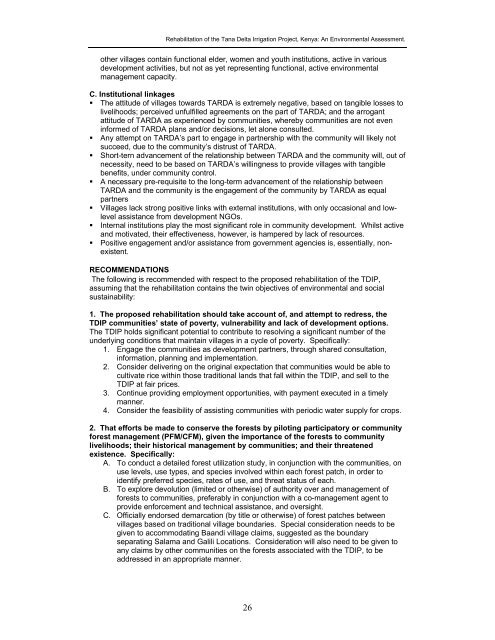Tana Delta Irrigation Project, Kenya: An Environmental Assessment
Tana Delta Irrigation Project, Kenya: An Environmental Assessment
Tana Delta Irrigation Project, Kenya: An Environmental Assessment
You also want an ePaper? Increase the reach of your titles
YUMPU automatically turns print PDFs into web optimized ePapers that Google loves.
Rehabilitation of the <strong>Tana</strong> <strong>Delta</strong> <strong>Irrigation</strong> <strong>Project</strong>, <strong>Kenya</strong>: <strong>An</strong> <strong>Environmental</strong> <strong>Assessment</strong>.<br />
other villages contain functional elder, women and youth institutions, active in various<br />
development activities, but not as yet representing functional, active environmental<br />
management capacity.<br />
C. Institutional linkages<br />
• The attitude of villages towards TARDA is extremely negative, based on tangible losses to<br />
livelihoods; perceived unfulfilled agreements on the part of TARDA; and the arrogant<br />
attitude of TARDA as experienced by communities, whereby communities are not even<br />
informed of TARDA plans and/or decisions, let alone consulted.<br />
• <strong>An</strong>y attempt on TARDA’s part to engage in partnership with the community will likely not<br />
succeed, due to the community’s distrust of TARDA.<br />
• Short-tern advancement of the relationship between TARDA and the community will, out of<br />
necessity, need to be based on TARDA’s willingness to provide villages with tangible<br />
benefits, under community control.<br />
• A necessary pre-requisite to the long-term advancement of the relationship between<br />
TARDA and the community is the engagement of the community by TARDA as equal<br />
partners<br />
• Villages lack strong positive links with external institutions, with only occasional and lowlevel<br />
assistance from development NGOs.<br />
• Internal institutions play the most significant role in community development. Whilst active<br />
and motivated, their effectiveness, however, is hampered by lack of resources.<br />
• Positive engagement and/or assistance from government agencies is, essentially, nonexistent.<br />
RECOMMENDATIONS<br />
The following is recommended with respect to the proposed rehabilitation of the TDIP,<br />
assuming that the rehabilitation contains the twin objectives of environmental and social<br />
sustainability:<br />
1. The proposed rehabilitation should take account of, and attempt to redress, the<br />
TDIP communities’ state of poverty, vulnerability and lack of development options.<br />
The TDIP holds significant potential to contribute to resolving a significant number of the<br />
underlying conditions that maintain villages in a cycle of poverty. Specifically:<br />
1. Engage the communities as development partners, through shared consultation,<br />
information, planning and implementation.<br />
2. Consider delivering on the original expectation that communities would be able to<br />
cultivate rice within those traditional lands that fall within the TDIP, and sell to the<br />
TDIP at fair prices.<br />
3. Continue providing employment opportunities, with payment executed in a timely<br />
manner.<br />
4. Consider the feasibility of assisting communities with periodic water supply for crops.<br />
2. That efforts be made to conserve the forests by piloting participatory or community<br />
forest management (PFM/CFM), given the importance of the forests to community<br />
livelihoods; their historical management by communities; and their threatened<br />
existence. Specifically:<br />
A. To conduct a detailed forest utilization study, in conjunction with the communities, on<br />
use levels, use types, and species involved within each forest patch, in order to<br />
identify preferred species, rates of use, and threat status of each.<br />
B. To explore devolution (limited or otherwise) of authority over and management of<br />
forests to communities, preferably in conjunction with a co-management agent to<br />
provide enforcement and technical assistance, and oversight.<br />
C. Officially endorsed demarcation (by title or otherwise) of forest patches between<br />
villages based on traditional village boundaries. Special consideration needs to be<br />
given to accommodating Baandi village claims, suggested as the boundary<br />
separating Salama and Galili Locations. Consideration will also need to be given to<br />
any claims by other communities on the forests associated with the TDIP, to be<br />
addressed in an appropriate manner.<br />
26

















